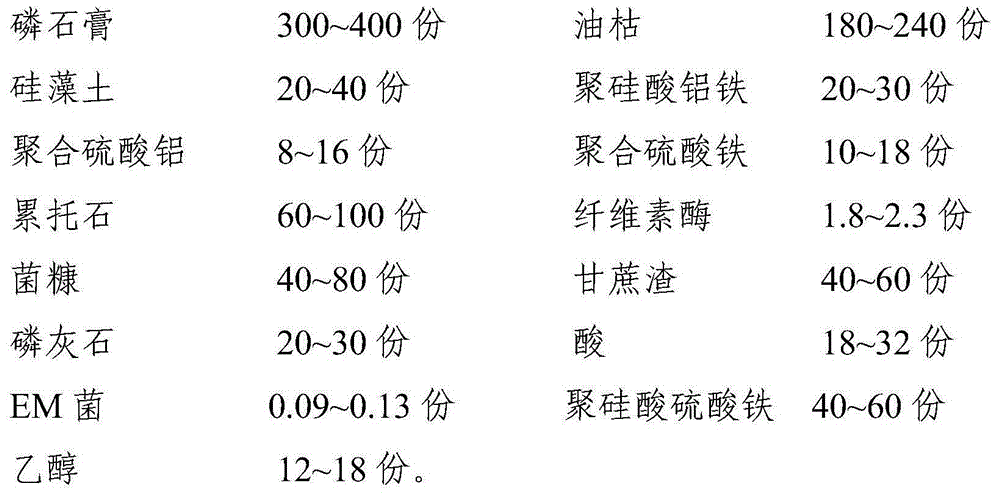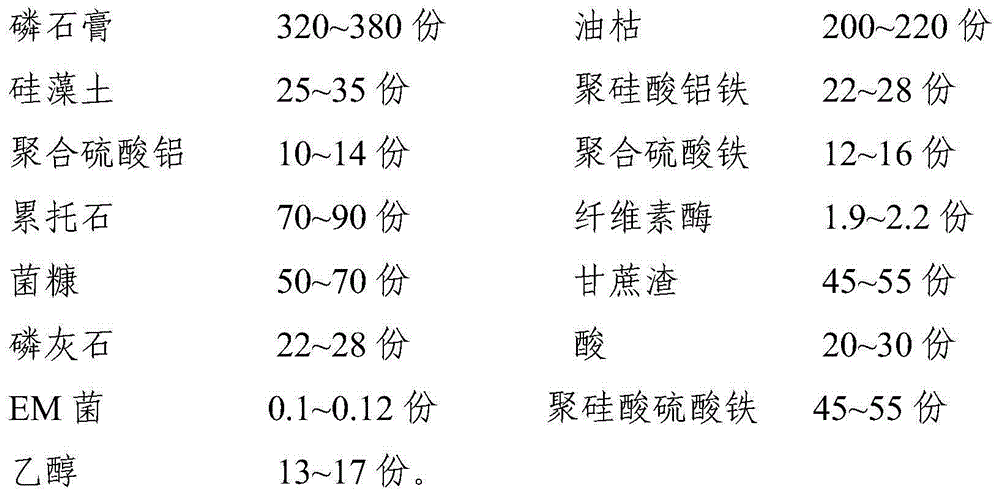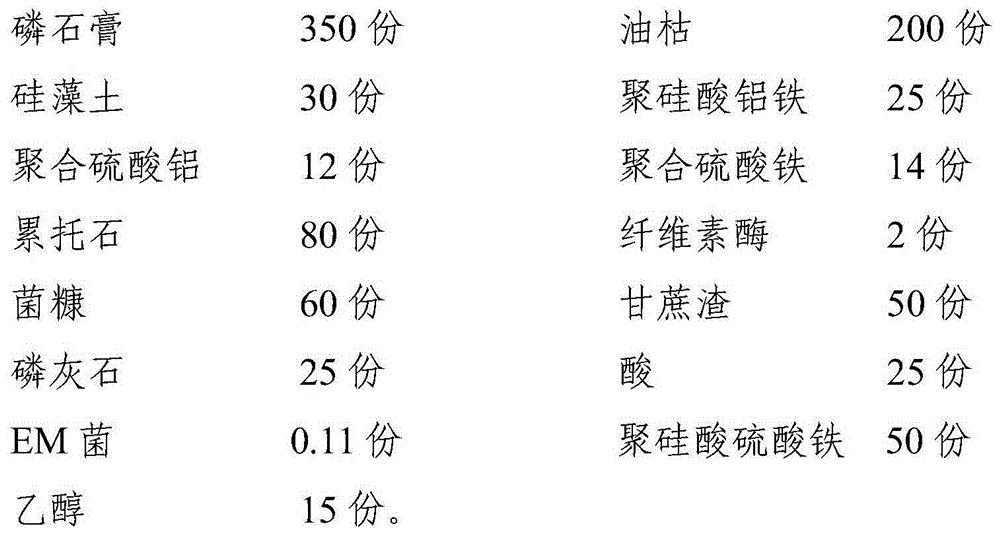Saline-alkali soil regulator and processing process and application thereof
A technology of processing technology and conditioner, which is applied in saline-alkali land conditioner and its processing technology and application field, can solve the problems of high cost of conditioner and low soil pH regulation ability, and improve physical and chemical properties, increase adsorption capacity, and increase specific surface area Effect
- Summary
- Abstract
- Description
- Claims
- Application Information
AI Technical Summary
Problems solved by technology
Method used
Image
Examples
Embodiment 1
[0038] raw material:
[0039] Phosphogypsum 300kg, oil dry 180kg, diatomite 20kg, polyaluminum ferric silicate 20kg, polyaluminum sulfate 8kg, polyferric sulfate 10kg, rectorite 60kg, cellulase 1.8kg, fungus chaff 40kg, bagasse 40kg, phosphorus Limestone 20kg, acid 18kg, EM bacteria 0.09kg, polysilicate ferric sulfate 40kg and ethanol 12kg.
[0040] Preparation:
[0041] (1) Drying phosphogypsum, diatomaceous earth, and apatite to a moisture content of 5% respectively, and then pulverizing them into 60-mesh fine powder to obtain phosphogypsum powder, diatomite powder and apatite powder;
[0042] (2) Use a ball mill to grind the rectorite into a fine powder with a fineness of ≤0.05mm, then send it into an ultrasonic device, process it at an ultrasonic power of 600w for 20min, and then send it into a calcination tower for calcination at a high temperature of 300°C for 2h, and cool it down Then send it into the reaction tank, then add nitric acid with a concentration of 20% in ...
Embodiment 2
[0048] raw material:
[0049] Phosphogypsum 400kg, oil dry 240kg, diatomite 40kg, polyaluminum ferric silicate 30kg, polyaluminum sulfate 16kg, polyferric sulfate 18kg, rectorite 100kg, cellulase 2.3kg, fungus chaff 80kg, bagasse 60kg, phosphorus Limestone 30kg, acid 32kg, EM bacteria 0.13kg, polysilicate ferric sulfate 60kg and ethanol 18kg.
[0050] Preparation:
[0051] (1) Drying phosphogypsum, diatomaceous earth, and apatite to a moisture content of 10% respectively, and then pulverizing them into 200-mesh fine powder to obtain phosphogypsum powder, diatomite powder and apatite powder;
[0052] (2) Use a ball mill to grind the rectorite into a fine powder with a fineness of ≤0.05mm, then send it into an ultrasonic device, process it at an ultrasonic power of 1000w for 40min, and then send it into a calciner tower for calcination at a high temperature of 600°C for 3h, and cool it down Afterwards, it is sent into the reaction tank, and acid is added according to the weigh...
Embodiment 3
[0058] raw material:
[0059] Phosphogypsum 350kg, oil dry 200kg, diatomite 30kg, polyaluminum ferric silicate 25kg, polyaluminum sulfate 12kg, polyferric sulfate 14kg, retortite 80kg, cellulase 2kg, fungus chaff 60kg, bagasse 50kg, apatite Stone 25kg, acid 25kg, EM bacteria 0.11kg, polysilicate ferric sulfate 50kg and ethanol 15kg.
[0060] Preparation:
[0061] (1) Drying phosphogypsum, diatomite, and apatite to a moisture content of 8% respectively, and then pulverizing them into 120-mesh fine powder to obtain phosphogypsum powder, diatomite powder and apatite powder;
[0062](2) Use a ball mill to grind the rectorite into a fine powder with a fineness of ≤0.05mm, then send it into an ultrasonic device, process it for 30 minutes at an ultrasonic power of 800w, and then send it to a calcination tower for calcination at a high temperature of 400°C for 3 hours, and cool it down Afterwards, send it into the reaction tank, then add acid according to the ratio of rectorite to a...
PUM
 Login to View More
Login to View More Abstract
Description
Claims
Application Information
 Login to View More
Login to View More - R&D
- Intellectual Property
- Life Sciences
- Materials
- Tech Scout
- Unparalleled Data Quality
- Higher Quality Content
- 60% Fewer Hallucinations
Browse by: Latest US Patents, China's latest patents, Technical Efficacy Thesaurus, Application Domain, Technology Topic, Popular Technical Reports.
© 2025 PatSnap. All rights reserved.Legal|Privacy policy|Modern Slavery Act Transparency Statement|Sitemap|About US| Contact US: help@patsnap.com



